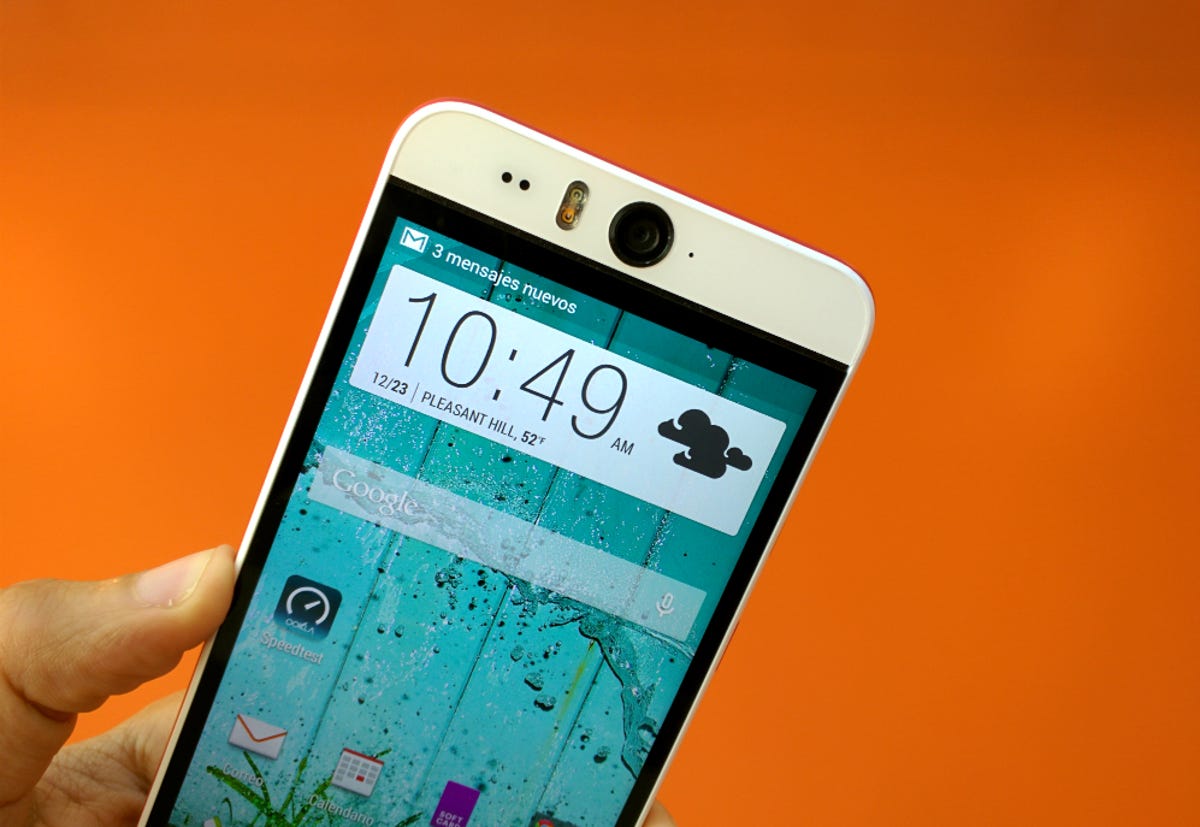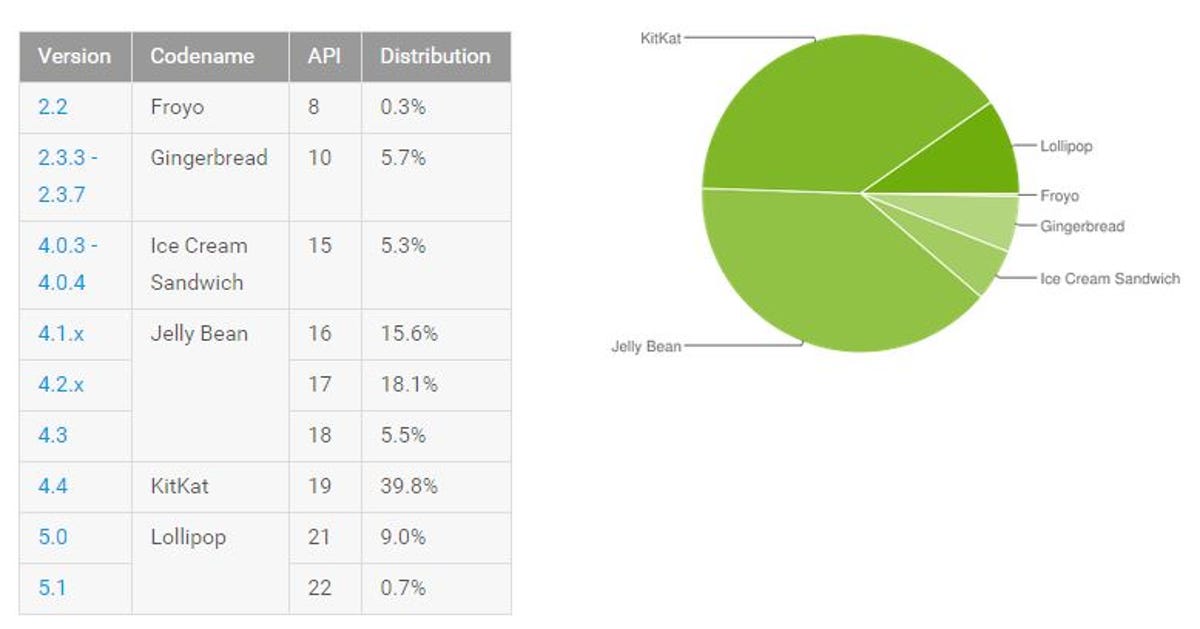
Sarah Tew/CNET
Android M, the next version of Google’s operating system for smartphones and tablets, was just unveiled at the company’s annual I/O developer conference.
And I couldn’t care less.
As a longtime Android fan I should have been excited for this moment. After all, I’ve been addicted to the platform since I purchased the Droid Eris back in 2009 — I even have little green Android figurines scattered across my desk. But excitement wasn’t my first reaction.
Android M isn’t exactly revolutionary, but it promises a bunch of interesting features. The Google Now personal assistant will be better with contextual searches (called Now On Tap), app permissions will be revamped and battery life will, allegedly, be better. Those all sound appealing — especially the battery life improvements — but I’m not as excited as I should be for one big reason:
I know I’ll probably never even see Android M on my current smartphone.
How do I know? Because six months after its debut, I don’t even have the most recent version of Android, 5.0 Lollipop .
The Apple way: Instant OS updates
When Apple releases a software update to its phones, all compatible devices — regardless of location or carrier — can download the update at the same time. Given that Apple has sold more than 700 million iPhones to date, and that all new models starting with 2011’s iPhone 4S are compatible with the latest version of iOS, that means that hundreds of millions of phones around the world can get the latest operating system on the same day that it’s released.
Even Microsoft — albeit with far fewer phones on its Windows OS — offers the same day and date software updates, regardless of phone carrier.
Unfortunately, this isn’t the case with Android. Despite (or, perhaps because of) being the biggest phone operating system in the world, updating Android phones is a rather long and complicated process.
Google first pushes its updated Android software to the members of the Open Handset Alliance (OHA), a consortium of more than 80 companies. Each manufacturer will then tweak the code for their respective devices. For example, Samsung must build TouchWiz — its unique skin, which modifies the look and feel and adds various distinguishing features — around each new version of Android. The same goes for HTC (Sense UI), LG, Sony and Motorola.
(For manufacturers that use a totally customized “fork” of Android — such as Xiaomi, Amazon and others — the customization road is an even more extensive process, but not really relevant to this conversation.)
If you have an unlocked (non-carrier specific) phone, that’s the end of the process — you get the update once the manufacturer distributes it. But for most of us, the phone is bought through a wireless carrier, adding yet another layer of bureaucracy to the software update process.
Each wireless carrier gets its own further customized version of the manufacturer’s Android software, which it then subjects to network compatibility testing. The carriers are the ultimate arbiter of when which update goes live for which devices on their networks. That’s why many times you will see an Android OS update hit, say, an AT&T phone, while that same device languishes on an older version on Verizon or Sprint.


Juan Garzón/CNET
So, between the manufacturers and wireless carriers, the end user can be stuck for months — sometimes half a year or more — waiting for an operating system update to hit his or her phone. So long, in fact, that the next update is already out, and it’s time for the waiting game to start again.
The problem gets even worse for those of us who have more obscure handset models. Many companies don’t want to bother updating less popular devices, even if they’re under a year old. For instance, my HTC Desire Eye can’t yet be updated to 2014’s Android 5.0 Lollipop operating system, because HTC never even bothered to cook it up. That makes me think it’s highly unlikely that I’ll be seeing 2015’s Android M, although HTC hasn’t confirmed or denied an update is in the works.
Of course, even if HTC does update it, I’ll need to wait until AT&T signs off on it…
The price of ‘not the same’
Fans of Google’s operating system attempt to defend the delays and point to issues that competitors have faced, such as the botched iOS 8.0.1 update a few months back, which temporarily crippled iPhones on some wireless carriers. But Android’s track record is far from perfect. Despite delays for “compatibility testing” users tend to flood sites like Reddit and Google’s own support forums with problems shortly after updates arrive. My previous Android phone was bricked and rendered useless from the Lollipop update a few months back.
The root of the problem, of course, is that Android is the Wild West, especially compared to the monolithic culture of Apple. All iPhones come from one manufacturer, and there’s no variation in their look and feel. Even Windows Phones, despite originating from a handful of different manufacturers, share a common user interface.
Google, instead, lets its manufacturing partners offer a fairly wide variety of customizations — all those aforementioned skins — whether or not they really add anything to the experience. Google’s slogan for Android —
— celebrates this diverse approach.
Yes, Google offers an alternative in the form of its Nexus phones. These carrier agnostic Google-blessed models offer “pure Android,” and are thus eligible for day-and-date OS updates the minute they’re available. The catch? You’ll probably need to forego contract subsidies or zero-interest monthly installment payments, leaving you to pay full price for the phone.
Even when a manufacturer eschews over-customization in the hopes of delivering more timely updates, the result can be mixed — just witness Motorola’s struggle to keep up with Google’s timetable.
With this universe of choice leaving so many of us lagging far behind the latest and greatest version of Android, I’m becoming more sympathetic to Apple’s “be the same, but fully in sync” approach. Less choice, sure — but at least you have access to the same cutting-edge features as everyone else with your operating system.
Perhaps the most troubling aspect of this story is that Google actually announced an initiative to improve Android software fragmentation way back in 2011. In terms of tech, four years is an eternity and Google has made little to no progress on the issue. When CNET contacted Google for an update, a company spokesperson told us: “We are continually working with carriers to ensure that Android users have a fast, safe experience with their devices.”


Screenshot by John P. Falcone
However, the very dashboard she pointed us to (reproduced above) shows the extent of the problem: Android Lollipop was released in November of 2014, yet as of May 2015 only 10 percent of devices run the software. (Yes, not all Android handsets are capable of running Lollipop, but I’d be willing to bet it’s significantly higher than 10 percent.)
Compare that to at least two-thirds of iPhones running iOS 8 or later, as of January 2015.
What’s an Android fan to do?
My CNET testing duties have me frequently using an iPhone, enough that I know I still prefer Android overall. So what can I do?
I could go out and purchase a new device such as the Galaxy S6 or LG G4 , two “hero” models that are more likely to be updated. I could buy a Google Nexus phone, which should get Android M on day one. Or I could attempt to install a customized “ROM” on my phone — basically a hacked, homebrew version of the latest software update — though doing so risks bricking the phone, or at least violating the warranty.
But the whole point is that I shouldn’t have to do any these things — nor should the tens of millions of other Android users. It’s time for Google to get serious about software updates and pressure its manufacturing and wireless carriers partners. Yes, the platform’s inherent openness makes it a much harder uphill battle compared to Apple and Microsoft.
But Google is a behemoth, with nearly limitless resources and plenty of negotiating power. The company should lay down the law: If you buy an Android device from a member of the OHA, that device should be supported with the latest software updates for at least two years (if not longer), and those updates should be propagated to end users within 30 days of initial availability, regardless of manufacturer or wireless carrier.
Until then, I just really can’t get excited for Android M.



